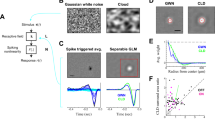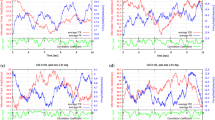Abstract
Firing-rate models provide a practical tool for studying signal processing in the early visual system, permitting more thorough mathematical analysis than spike-based models. We show here that essential response properties of relay cells in the lateral geniculate nucleus (LGN) can be captured by surprisingly simple firing-rate models consisting of a low-pass filter and a nonlinear activation function. The starting point for our analysis are two spiking neuron models based on experimental data: a spike-response model fitted to data from macaque (Carandini et al. J. Vis., 20(14), 1–2011, 2007), and a model with conductance-based synapses and afterhyperpolarizing currents fitted to data from cat (Casti et al. J. Comput. Neurosci., 24(2), 235–252, 2008). We obtained the nonlinear activation function by stimulating the model neurons with stationary stochastic spike trains, while we characterized the linear filter by fitting a low-pass filter to responses to sinusoidally modulated stochastic spike trains. To account for the non-Poisson nature of retinal spike trains, we performed all analyses with spike trains with higher-order gamma statistics in addition to Poissonian spike trains. Interestingly, the properties of the low-pass filter depend only on the average input rate, but not on the modulation depth of sinusoidally modulated input. Thus, the response properties of our model are fully specified by just three parameters (low-frequency gain, cutoff frequency, and delay) for a given mean input rate and input regularity. This simple firing-rate model reproduces the response of spiking neurons to a step in input rate very well for Poissonian as well as for non-Poissonian input. We also found that the cutoff frequencies, and thus the filter time constants, of the rate-based model are unrelated to the membrane time constants of the underlying spiking models, in agreement with similar observations for simpler models.










Similar content being viewed by others
References
Blitz, D.M., & Regehr, W.G. (2005). Timing and specificity of feed-forward inhibition within the L.G.N. Neuron, 45(6), 917–928.
Brown, E.N., Barbieri, R., Ventura, V., Kass, R.E., Frank, L.M. (2002). The time-rescaling theorem and its application to neural spike train data analysis. Neural Computation, 14(2), 325–346.
Brunel, N., Chance, F.S., Fourcaud, N., Abbott, L.F. (2001). Effects of synaptic noise and filtering on the frequency response of spiking neurons. Physical Review Letters, 86(10), 2186–2189.
Carandini, M., Horton, J.C., Sincich, L.C. (2007). Thalamic filtering of retinal spike trains by postsynaptic summation. Journal of Vision, 20(14), 1–2011.
Casti, A., Hayot, F., Xiao, Y., Kaplan, E. (2008). A simple model of retina-LGN transmission. Journal of Computational Neuroscience, 24(2), 235–252.
Chichilnisky, E.J. (2001). A simple white noise analysis of neuronal light responses. Network, 12(2), 199–213.
Cleland, B.G., Dubin, M.W., Levick, W.R. (1971). Simultaneous recording of input and output of lateral geniculate neurones. Nature New Biology, 231(23), 191–192.
Dayan, P., & Abbott, L.F. (2001). Theoretical neuroscience. Cambridge: Massachusetts Institute of Technology Press.
Deger, M., Helias, M., Cardanobile, S., Atay, F.M., Rotter, S. (2010). Nonequilibrium dynamics of stochastic point processes with refractoriness. Physical Review E, 82(2 Pt 1), 021–129.
Einevoll, G.T., & Heggelund, P. (2000). Mathematical models for the spatial receptive-field organization of nonlagged X-cells in dorsal lateral geniculate nucleus of cat. Visual Neuroscience, 17(6), 871–885.
Einevoll, G.T., & Plesser, H.E. (2002). Linear mechanistic models for the dorsal lateral geniculate nucleus of cat probed using drifting-grating stimuli. Network, 13(4), 503–530.
Franklin, J., & Bair, W. (1995). The effect of a refractory period on the power spectrum of neuronal discharge. SIAM Journal on Applied Mathematics, 55, 1074–1093.
Galassi, M., Davies, J., Theiler, J., Gough, B., Jungman, G., Booth, M., Rossi, F. (2001). GNU scientific library reference manual. Bristol: Network Theory.
Gerstner, W. (2000). Population dynamics of spiking neurons: fast transients, asynchronous states, and locking. Neural Computation, 12(1), 43–89.
Gerstner, W., & Kistler, W.M. (2002). Spiking neuron models. Cambridge: Cambridge University Press.
Gewaltig, M.O., & Diesmann, M. (2007). NEST (NEural simulation tool). Scholarpedia, 2(4), 1430.
Goldberg, J.M., & Brown, P.B. (1969). Response of binaural neurons of dog superior olivary complex to dichotic tonal stimuli: Some physiological mechanisms of sound localization. Journal of Neurophysiology, 32, 613–636.
Hayot, F., & Tranchina, D. (2001). Modeling corticofugal feedback and the sensitivity of lateral geniculate neurons to orientation discontinuity. Visual Neuroscience, 18(6), 865–877.
Johannesma, P.I.M. (1968). Diffusion models for the stochastic activity of neurons. In E.R. Caianiello (Ed.), Networks neural: Proceedings of the school on neural networks (pp. 116–144). Springer-Verlag.
Kaplan, E., & Shapley, R. (1984). The origin of the S (slow) potential in the mammalian lateral geniculate nucleus. Experimental Brain Research, 55(1), 111–116.
Kirkland, K.L., & Gerstein, G.L. (1998). A model of cortically induced synchronization in the lateral geniculate nucleus of the cat: a role for low-threshold calcium channels. Vision Research, 38(13), 2007–2022.
Knight, B.W. (1972). Dynamics of encoding in a population of neurons. The Journal of General Physiology, 59(6), 734–766.
Köhn, J., & Wörgötter, F. (1996). Corticofugal feedback can reduce the visual latency of responses to antagonistic stimuli. Biological Cybernetics, 75(3), 199–209.
Muller, E., Davison, A.P., Brizzi, T., Bruederle, D., Eppler, J.M., Kremkow, J., Pecevski, D., Perrinet, L., Schmuker, M., Yger, P. (2009). NeuralEnsemble.Org: Unifying neural simulators in Python to ease the model complexity bottleneck. In Frontiers in neuroscience conference abstract: Neuroinformatics 2009.
Nelder, J.A., & Mead, R. (1965). A simplex method for function minimization. Computer Journal, 7, 308–313.
Nordbø, Ø., Wyller, J., Einevoll, G.T. (2007). Neural network firing-rate models on integral form: effects of temporal coupling kernels on equilibrium-state stability. Biological Cybernetics, 97(3), 195–209.
Nordlie, E., Gewaltig, M.O., Plesser, H.E. (2009). Towards reproducible descriptions of neuronal network models. PLoS Computational Biology, 5(8), e1000456.
Nordlie, E., Tetzlaff, T., Einevoll, G.T. (2010). Rate dynamics of leaky integrate-and-fire neurons with strong synapses. Frontiers in Computational Neuroscience, 4, 149.
Pillow, J.W., Paninski, L., Uzzell, V.J., Simoncelli, E.P., Chichilnisky, E.J. (2005). Prediction and decoding of retinal ganglion cell responses with a probabilistic spiking model. Journal of Neuroscience, 25(47), 11003–11013.
Pillow, J.W., Shlens, J., Paninski, L., Sher, A., Litke, A.M., Chichilnisky, E.J., Simoncelli, E.P. (2008). Spatio-temporal correlations and visual signalling in a complete neuronal population. Nature, 454(7207), 995–999.
Plesser, H.E., & Diesmann, M. (2009). Simplicity and efficiency of integrate-and-fire neuron models. Neural Computation, 21, 353–359.
Rodieck, R.W. (1965). Quantitative analysis of cat retinal ganglion cell response to visual stimuli. Vision Research, 5(11), 583–601.
Rotter, S., & Diesmann, M. (1999). Exact digital simulation of time-invariant linear systems with applications to neuronal modeling. Biological Cybernetics, 81(5–6), 381–402.
Sherman, S.M., & Guillery, R.W. (2001). Exploring the thalamus. New York: Academic Press.
Shimazaki, H., & Shinomoto, S. (2010). Kernel bandwidth optimization in spike rate estimation. Journal of Computational Neuroscience, 29(1–2), 171–182.
Sirovich, L. (2008). Populations of tightly coupled neurons: the RGC/LGN system. Neural Computation, 20(5), 1179–1210.
Troy, J.B., & Robson, J.G. (1992). Steady discharges of X and Y retinal ganglion cells of cat under photopic illuminance. Visual neuroscience, 9(6), 535–53.
van Hateren, J.H. (1997). Processing of natural time series of intensities by the visual system of the blowfly. Vision Research, 37(23), 3407–3416.
Walpole, R.E., & Myers, R.H. (1993). Probability and Statistics for Engineers and Scientists (5th Ed.). Englewood Cliffs: Prentice Hall.
Wilson, H.R., & Cowan, J.D. (1972). Excitatory and inhibitory interactions in localized populations of model neurons. Biophysical Journal, 12(1), 1–24.
Yousif, N., & Denham, M. (2007). The role of cortical feedback in the generation of the temporal receptive field responses of lateral geniculate nucleus neurons: a computational modelling study. Biological Cybernetics, 97(4), 269–277.
Acknowledgments
We would like to thank Matteo Carandini for valuable discussions on how to replicate his model and two anonymous referees for constructive comments.
Conflict of interest
The authors declare that they have no conflict of interest.
Author information
Authors and Affiliations
Corresponding author
Additional information
Action Editor: David Golomb
Partially funded by the Research Council of Norway (Grant 178892/V30 eNeuro), the Helmholtz Alliance on Systems Biology, and EU Grant 269921 (BrainScaleS). Simulations were performed using NOTUR resources.
Electronic supplementary material
Below is the link to the electronic supplementary material.
Rights and permissions
About this article
Cite this article
Heiberg, T., Kriener, B., Tetzlaff, T. et al. Firing-rate models capture essential response dynamics of LGN relay cells. J Comput Neurosci 35, 359–375 (2013). https://doi.org/10.1007/s10827-013-0456-6
Received:
Revised:
Accepted:
Published:
Issue Date:
DOI: https://doi.org/10.1007/s10827-013-0456-6




